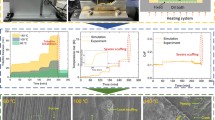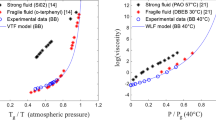Abstract
The transient tribological phenomenon and premature lubricant breakdown have been widely observed in metal forming, leading to excessive friction at the contact interfaces. In this research, the transient tribological behaviour of a two-phase lubricant were studied under complex loading conditions, featuring abrupt interfacial temperature, contact load, and sliding speed changes, thus representing the severe interfacial conditions observed in warm/hot metal forming applications. The strong experimental evidence indicates that the evolution of friction was attributed to the physical diminution and chemical decomposition effects. As such, a visco-mechanochemical interactive friction model was developed to accurately predict the transient tribological behaviour of the two-phase lubricant under complex loading conditions. The new friction model exhibited close agreements between the modelling and experimental results.

Article PDF
Similar content being viewed by others
Avoid common mistakes on your manuscript.
References
Zhang J, Ewen J P, Ueda M, Wong J S S, Spikes H A. Mechanochemistry of zinc dialkyldithiophosphate on steel surfaces under elastohydrodynamic lubrication conditions. ACS Appl Mater Interfaces 12(5): 6662–6676 (2020)
Hu Y, Zheng Y, Politis D J, Masen M A, Cui J, Wang L. Development of an interactive friction model to predict aluminum transfer in a pin-on-disc sliding system. Tribol Int 130: 216–228 (2019)
Ma G J, Wang L L, Gao H X, Zhang J, Reddyhoff T. The friction coefficient evolution of a TiN coated contact during sliding wear. Appl Surf Sci 345: 109–115 (2015)
Yang X, Liu X C, Liu H L, Politis D J, Leyvraz D, Wang L L. Experimental and modelling study of friction evolution and lubricant breakdown behaviour under varying contact conditions in warm aluminium forming processes. Tribol Int 158: 106934 (2021)
Karbasian H, Tekkaya A E. A review on hot stamping. J Mater Process Technol 210(15): 2103–2118 (2010)
Wang Z, Dohda K, Haruyama Y. Effects of entraining velocity of lubricant and sliding velocity on friction behavior in stainless steel sheet rolling. Wear 260(3): 249–257 (2006)
Pereira M P, Yan W Y, Rolfe B F. Sliding distance, contact pressure and wear in sheet metal stamping. Wear 268(11–12): 1275–1284 (2010)
Bhushan B. Introduction to Tribology. UK: John Wiley & Sons, Ltd., 2013.
Bay N, Olsson D D, Andreasen J L. Lubricant test methods for sheet metal forming. Tribol Int 41(9–10): 844–853 (2008)
Hu Y, Wang L, Politis D J, Masen M A. Development of an interactive friction model for the prediction of lubricant breakdown behaviour during sliding wear. Tribol Int 110: 370–377 (2017)
Noder J, George R, Butcher C, Worswick M J. Friction characterization and application to warm forming of a high strength 7000-series aluminum sheet. J Mater Process Technol 293: 117066 (2021)
Cui S G, Zhu H T, Wan S H, Tran B, Wang L, Tieu K. Investigation of different inorganic chemical compounds as hot metal forming lubricant by pin-on-disc and hot rolling. Tribol Int 125: 110–120 (2018)
Xia W Z, Zhao J W, Wu H, Zhao X M, Zhang X M, Xu J Z, Jiao S H, Wang X G, Zhou C L, Jiang Z Y. Effects of oil-in-water based nanolubricant containing TiO2 nanoparticles in hot rolling of 304 stainless steel. J Mater Process Technol 262: 149–156 (2018)
Liu Y, Zhu B, Wang K, Li S Q, Zhang Y S. Friction behaviors of 6061 aluminum alloy sheets in hot stamping under dry and lubricated conditions based on hot strip drawing test. Tribol Int 151: 106504 (2020)
Dong Y C, Zheng K L, Fernandez J, Fuentes G, Li X Y, Dong H S. Tribology and hot forming performance of self-lubricious NC/NiBN and NC/WC: C hybrid composite coatings for hot forming Die. J Mater Process Technol 252: 183–190 (2018)
Yang X, Zhang Q L, Zheng Y, Liu X C, Politis D, Fakir O E, Wang L L. Investigation of the friction coefficient evolution and lubricant breakdown behaviour of AA7075 aluminium alloy forming processes at elevated temperatures. Int J Extrem Manuf 3(2): 025002 (2021)
Huang H D, Tu J P, Gan L P, Li C Z. An investigation on tribological properties of graphite nanosheets as oil additive. Wear 261(2): 140–144 (2006)
Holinski R. Lubrication mechanism of solid lubricants in oils. S L E Trans 18(4): 263–269 (1975)
Bartz W J. Some investigations on the influence of particle size on the lubricating effectiveness of molybdenum disulfide. S L E Trans 15(3): 207–215 (1972)
Wu H X, Khan A M, Johnson B, Sasikumar K, Chung Y W, Wang Q J. Formation and nature of carbon-containing tribofilms. ACS Appl Mater Interfaces 11(17): 16139–16146 (2019)
Seymour B, Fu W X, Wright R A E, Luo H M, Qu J, Dai S, Zhao B. Improved lubricating performance by combining oil-soluble hairy silica nanoparticles and an ionic liquid as an additive for a synthetic base oil. ACS Appl Mater Interfaces 10(17): 15129–15139 (2018)
Li X W, Zhang D K, Xu X W, Lee K R. Tailoring the nanostructure of graphene as an oil-based additive: Toward synergistic lubrication with an amorphous carbon film. ACS Appl Mater Interfaces 12(38): 43320–43330 (2020)
Chouhan A, Kumari S, Sarkar T K, Rawat S S, Khatri O P. Graphene-based aqueous lubricants: Dispersion stability to the enhancement of tribological properties. ACS Appl Mater Interfaces 12(46): 51785–51796 (2020)
Yousif A E, Nacy S M. Hydrodynamic behaviour of two-phase (liquid-solid) lubricants. Wear 66(2): 223–240 (1981)
Feng N S, Hahn E J. Density and viscosity models for two-phase homogeneous hydrodynamic damper fluids. S L E Trans 29(3): 361–369 (1986)
Alberts M, Kalaitzidou K, Melkote S. An investigation of graphite nanoplatelets as lubricant in grinding. Int J Mach Tools Manuf 49(12–13): 966–970 (2009)
Vazirisereshk M R, Martini A, Strubbe D A, Baykara M Z. Solid lubrication with MoS2: A review. Lubricants 7(7): 57 (2019)
Sliney H E. Solid lubricant materials for high temperatures— A review. Tribol Int 15(5): 303–315 (1982)
Hol J, Meinders V T, de Rooij M B, van den Boogaard A H. Multi-scale friction modeling for sheet metal forming: The boundary lubrication regime. Tribol Int 81: 112–128 (2015)
Hol J, Meinders V T, Geijselaers H J M, van den Boogaard A H. Multi-scale friction modeling for sheet metal forming: The mixed lubrication regime. Tribol Int 85: 10–25 (2015)
Shisode M, Hazrati J, Mishra T, de Rooij M, van den Boogaard T. Mixed lubrication friction model including surface texture effects for sheet metal forming. J Mater Process Technol 291: 117035 (2021)
Shisode M, Hazrati J, Mishra T, de Rooij M, Horn C T, van Beeck J, van den Boogaard T. Modeling boundary friction of coated sheets in sheet metal forming. Tribol Int 153: 106554 (2021)
Yang X. Lubricant 4.0: Digitally enhanced lubricant development for metal forming applications. Ph.D. Thesis. London (UK): Imperial College London, 2021.
Dohda K, Boher C, Rezai-Aria F, Mahayotsanun N. Tribology in metal forming at elevated temperatures. Friction 3(1): 1–27 (2015)
Wang L, He Y, Zhou J, Duszczyk J. Modelling of plowing and shear friction coefficients during high-temperature ballon-disc tests. Tribol Int 42(1): 15–22 (2009)
Seeton C J. Viscosity-temperature correlation for liquids. In Proceedings of the International Joint Tribology Conference, San Antonio, USA, 2006: 131–142.
Liu X C, Yang X, Sun Y H, Politis D J, Mori K I, Wang L L. Characterization of thermomechanical boundary conditions of a martensitic steel for a FAST forming process. J Manuf Mater Process 4(2): 57 (2020)
Begelinger A, Gee A W J D. Failure of thin film lubrication—A detailed study of the lubricant film breakdown mechanism. Wear 77(1): 57–63 (1982)
Dowson D, Whomes T L. Paper 8: Side-leakage factors for a rigid cylinder lubricated by an isoviscous fluid. Proc Inst Mech Eng Conf Proc. London: SAGE Publications Sage, 1966: 165–176.
Carey F A, Sundberg R J. Advanced Organic Chemistry— Part A: Structure and Mechanisms. Springer Science & Business Media, 2007.
Connors K A. Chemical Kinetics: the Study of Reaction Rates in Solution. New York (USA): Wiley-VCH Verlag GmbH; 1990.
Archard J F. Contact and rubbing of flat surfaces. J Appl Phys 24(8): 981–988 (1953)
Korsunsky A M, McGurk M R, Bull S J, Page T F. On the hardness of coated systems. Surf Coat Technol 99(1–2): 171–183 (1998)
Komvopoulos K. Sliding friction mechanisms of boundary-lubricated layered surfaces: Part II—theoretical analysis. Tribol Trans 34(2): 281–291 (1991)
Acknowledgements
This study was supported by the China Scholarship Council (CSC) with Grant No. 201706230235. CSC is national institution that supports Chinese students to participate in overseas M.S. and Ph.D. programs. In addition, the strong support from the Institute of Automation, Heilongjiang Academy of Sciences, for this funded research is much appreciated.
Author information
Authors and Affiliations
Corresponding author
Additional information
Xiao YANG. She is a Ph.D. candidate in the Department of Mechanical Engineering at Imperial College London, UK. She received her M.S. degree in the Institute of Forming Technology and Equipment, Shanghai Jiao Tong University, China, in 2017. Her current research focuses on friction characterisation and interfacial behaviours in hot/warm metal forming processes.
Lemeng ZHANG. She is studying for a M.S. degree in mechanical engineering at Imperial College London, UK. She obtained her B.S. degree in 2020 from University College London, UK. Her current research focuses on the development of an autonomous laboratory system to study the friction and lubricant breakdown during hot metal forming.
Denis J. POLITIS. He is a Lecturer and head of the Manufacturing and Materials Modelling laboratory in the Department of Mechanical and Manufacturing Engineering at the University of Cyprus. He has more than 10 years research experience in sheet metal forming and forging technologies. He has worked on numerous research projects in collaboration with industrial companies that have been sponsored by European FP7 and H2020 grants.
Jie ZHANG. He received his M.S. degree in tribology and surface engineering from thr China University of Geosciences (Beijing) in 2007. He subsequently joined the Tribology Group in Imperial College London as a Ph.D. student and completed in 2011. Since 2013 he started to work in the same group as a research associate on different projects. His main research areas cover boundary lubrication, wear, lubricant additives, elasto-hydrodynamic lubrication (EHD), micro-electro-mechanical system (MEMS), zinc dialkyldithiophosphate (ZDDP), mechanochemistry, and atmospheric Tribology.
Mohammad M. GHARBI. He is an Europe, Middle East, Africa (EMEA) business development manager for the Hot and Warm Forming/Forging Technologies at Quaker Houghton. He has broad technical expertise from managing operations to negotiating complex transformation projects across all forming technologies, hot forming and forging lubricants market in Europe, Russia, North America, and Asia.
I David LEYVRAZ. He is a R&D Metallurgy Scientist at Novelis. His expertise is mainly on the high-strength aluminium alloy development for automotive applications, both on the production process (rolling, forming) and the in-service properties (crash).
Liliang WANG. He is the head of Metal Forming and Modelling Group at Imperial College London. His major research interests include the design and development of advanced metal forming technologies and manufacturing system. His work has made fundamental contributions to the characterization and modelling of materials and interfacial behaviours of engineering materials.
Rights and permissions
Open Access This article is licensed under a Creative Commons Attribution 4.0 International License, which permits use, sharing, adaptation, distribution and reproduction in any medium or format, as long as you give appropriate credit to the original author(s) and the source, provide a link to the Creative Commons licence, and indicate if changes were made.
The images or other third party material in this article are included in the article’s Creative Commons licence, unless indicated otherwise in a credit line to the material. If material is not included in the article’s Creative Commons licence and your intended use is not permitted by statutory regulation or exceeds the permitted use, you will need to obtain permission directly from the copyright holder.
To view a copy of this licence, visit http://creativecommons.org/licenses/by/4.0/.
About this article
Cite this article
Yang, X., Zhang, L., Politis, D.J. et al. Experimental and modelling studies of the transient tribological behaviour of a two-phase lubricant under complex loading conditions. Friction 10, 911–926 (2022). https://doi.org/10.1007/s40544-021-0542-0
Received:
Revised:
Accepted:
Published:
Issue Date:
DOI: https://doi.org/10.1007/s40544-021-0542-0




